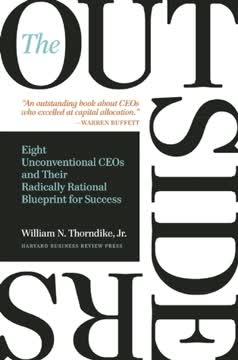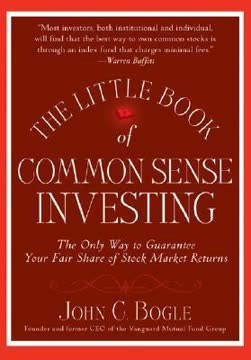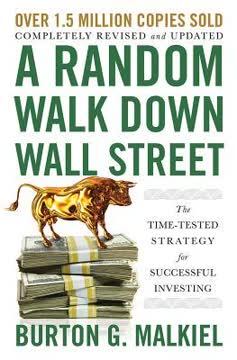Key Takeaways
1. Our Brains Are Wired for Emotional Investing
"Emotion is designed to trump logic."
Two systems of thinking. Our brains have two systems for decision-making: the emotional X-system and the logical C-system. The X-system is quick, automatic, and often based on intuition, while the C-system is slower, more deliberate, and logical. In investing, the X-system can lead to impulsive decisions based on fear or greed.
Overcoming emotional bias. To make better investment decisions, we need to engage our C-system more often. This can be done by:
- Slowing down decision-making processes
- Seeking out contradictory information
- Using pre-commitment strategies, like setting rules for buying or selling
- Developing a systematic investment approach
Understanding these mental pitfalls is crucial for investors. By recognizing when emotions are driving decisions, we can take steps to counteract them and make more rational choices.
2. Overconfidence: The Enemy of Smart Investing
"Those who have knowledge don't predict. Those who predict don't have knowledge."
The illusion of control. Investors often overestimate their ability to predict market movements and pick winning stocks. This overconfidence leads to excessive trading, which typically results in lower returns due to transaction costs and poor timing.
Experts are not immune. Studies show that professional analysts and fund managers are just as prone to overconfidence as individual investors. Their forecasts are often no more accurate than chance, yet they express high levels of certainty in their predictions.
To combat overconfidence:
- Keep a detailed investment journal to track decisions and outcomes
- Regularly review and analyze past mistakes
- Seek out diverse opinions and viewpoints
- Focus on process rather than short-term results
3. The Folly of Forecasting in Finance
"We simply do not know."
The futility of prediction. Extensive research shows that financial forecasts, whether for economic indicators, earnings, or stock prices, are consistently inaccurate. Yet the investment industry remains obsessed with trying to predict the future.
Alternative approaches. Instead of relying on forecasts, investors should:
- Focus on understanding a company's intrinsic value
- Look for a margin of safety in valuations
- Prepare for multiple scenarios rather than trying to predict a single outcome
- Use reverse-engineered DCF models to understand market expectations
By accepting the inherent uncertainty in markets, investors can focus on more productive activities that add value to their investment process.
4. Information Overload: Less is Often More
"Analysis should be penetrating not prophetic."
The dangers of too much data. Studies show that access to more information often leads to lower accuracy but higher confidence in investment decisions. This paradox occurs because humans have limited processing capacity and tend to focus on less relevant data when overwhelmed.
Focusing on what matters. To combat information overload:
- Identify the 3-5 key factors that drive an investment's success
- Create simple checklists to guide decision-making
- Limit exposure to short-term market noise and financial media
- Regularly review and refine your information sources
By concentrating on a few critical pieces of information, investors can make better decisions and avoid the pitfalls of analysis paralysis.
5. The Siren Song of Stories in Investment Decisions
"We will abandon evidence in favour of a good story."
The power of narratives. Humans are naturally drawn to compelling stories, often at the expense of factual analysis. In investing, this can lead to overvaluing stocks with exciting narratives (like IPOs) and undervaluing solid but boring businesses.
Focusing on facts. To avoid being swayed by narratives:
- Separate qualitative stories from quantitative data
- Look for evidence that contradicts the prevailing narrative
- Use checklists and systematic processes to evaluate investments
- Be especially skeptical of "new era" and "this time is different" stories
By maintaining a healthy skepticism towards narratives and focusing on hard data, investors can avoid common pitfalls and identify truly valuable opportunities.
6. Contrarian Investing: The Power of Going Against the Crowd
"It is impossible to produce superior performance unless you do something different from the majority."
The pain of nonconformity. Going against the crowd is psychologically difficult. Studies show that social exclusion activates the same brain regions as physical pain, explaining why many investors struggle to be contrarian.
Cultivating contrarian thinking. To become a successful contrarian investor:
- Develop a strong understanding of market history and cycles
- Build conviction through thorough research and analysis
- Create a support network of like-minded investors
- Be prepared for periods of underperformance and social discomfort
Remember that the greatest investment opportunities often arise when fear or euphoria are at their peak, and most investors are acting irrationally.
7. Loss Aversion: Why We Can't Let Go of Losing Investments
"You gotta know when to hold them, know when to fold them, know when to walk away, and know when to run."
The psychology of losses. Humans feel the pain of losses about twice as strongly as the pleasure of equivalent gains. This leads to behaviors like holding onto losing stocks too long and selling winners too early.
Overcoming loss aversion. Strategies to combat this bias include:
- Setting predetermined sell rules or stop-losses
- Regularly reviewing positions as if you were buying them fresh
- Focusing on overall portfolio performance rather than individual positions
- Understanding the difference between temporary paper losses and permanent capital loss
By recognizing and actively managing our aversion to losses, we can make more rational decisions about when to cut our losses and when to let winners run.
8. Focus on Process, Not Outcomes, for Long-Term Success
"Championship organizations, however, reside exclusively in the upper half of the matrix."
The importance of process. In the short term, good decisions can lead to bad outcomes due to randomness. Conversely, poor decisions can sometimes result in good outcomes. Focusing solely on outcomes can reinforce bad habits and lead to long-term underperformance.
Building a robust investment process. Key elements include:
- Developing a clear investment philosophy and strategy
- Creating systematic rules for buying, selling, and position sizing
- Regularly reviewing and refining your process based on new information
- Measuring performance against appropriate benchmarks over long time horizons
By concentrating on building and following a sound investment process, investors can increase their odds of success and maintain discipline during periods of market volatility or poor short-term performance.
Last updated:
FAQ
What's "The Little Book of Behavioral Investing" about?
- Behavioral Finance Focus: The book explores how human psychology affects investment decisions, often leading to suboptimal outcomes.
- Common Pitfalls: It identifies common behavioral biases that investors face, such as overconfidence, loss aversion, and the tendency to follow the crowd.
- Improving Decision-Making: The author, James Montier, provides strategies to recognize and mitigate these biases to improve investment performance.
- Practical Examples: The book uses real-world examples and anecdotes to illustrate how these biases manifest in everyday investing.
Why should I read "The Little Book of Behavioral Investing"?
- Understand Your Biases: It helps readers identify their own psychological biases that can negatively impact investment decisions.
- Improve Investment Returns: By learning to control these biases, investors can potentially improve their investment returns.
- Expert Insights: The book offers insights from some of the world's best investors on how they manage behavioral challenges.
- Engaging and Accessible: Written in an engaging style, it makes complex psychological concepts accessible to a broad audience.
What are the key takeaways of "The Little Book of Behavioral Investing"?
- Self-Awareness is Crucial: Recognizing one's own biases is the first step toward better investment decisions.
- Pre-Commitment Strategies: Planning and committing to a strategy in advance can help avoid emotional decision-making.
- Skepticism and Critical Thinking: Investors should cultivate skepticism and focus on facts rather than stories or market noise.
- Long-Term Focus: Patience and a long-term perspective are essential to overcoming short-term market volatility and biases.
What are the best quotes from "The Little Book of Behavioral Investing" and what do they mean?
- "The investor’s chief problem—and even his worst enemy—is likely to be himself." This highlights the idea that personal biases and emotions are significant obstacles to successful investing.
- "Investing is simple but not easy." This suggests that while the principles of investing are straightforward, executing them without succumbing to biases is challenging.
- "The time of maximum pessimism is the best time to buy." This quote emphasizes the contrarian approach of buying when others are fearful, which can lead to better investment opportunities.
- "You can’t predict, you can prepare." This underscores the importance of preparation and process over trying to forecast market movements.
How does James Montier suggest overcoming behavioral biases in investing?
- Pre-Commitment: Montier advises investors to prepare and pre-commit to strategies when in a rational state, avoiding decisions made in the heat of the moment.
- Focus on Process: Emphasizing a disciplined investment process can help mitigate the influence of emotions and biases.
- Critical Thinking: Investors should question assumptions and seek disconfirming evidence to avoid confirmatory bias.
- Learn from Mistakes: Keeping an investment diary can help track decisions and learn from past mistakes, distinguishing between luck and skill.
What is the "X-system" and "C-system" in "The Little Book of Behavioral Investing"?
- X-System: This represents the emotional, quick, and automatic way of processing information, often leading to biases and errors.
- C-System: In contrast, the C-system is the logical, deliberate, and effortful way of thinking, which is slower but more accurate.
- Balancing Both Systems: Montier suggests that while both systems are necessary, investors should strive to engage the C-system more in decision-making.
- Practical Application: Understanding these systems can help investors recognize when they are making decisions based on emotion rather than logic.
What role does overconfidence play in investing according to James Montier?
- Common Bias: Overconfidence is a prevalent bias where investors overestimate their knowledge and ability to predict market movements.
- Impact on Trading: It often leads to excessive trading, which can erode returns due to transaction costs and poor timing.
- Expert Overconfidence: Even experts are not immune, often displaying more overconfidence than laypeople, which can lead to significant errors.
- Mitigation Strategies: Montier suggests being aware of this bias and implementing checks, such as seeking diverse opinions and focusing on process over predictions.
How does "The Little Book of Behavioral Investing" address the issue of information overload?
- More Isn't Always Better: Montier argues that more information can lead to overconfidence without improving decision accuracy.
- Focus on Key Factors: Investors should identify and focus on the few critical factors that truly impact investment decisions.
- Checklists and Simplicity: Using checklists can help streamline decision-making and ensure focus on relevant information.
- Avoiding Noise: Montier advises turning off "bubblevision" and ignoring market noise to concentrate on long-term fundamentals.
What is the "disposition effect" and how does it affect investors?
- Definition: The disposition effect is the tendency to sell winning investments too early and hold onto losing ones too long.
- Emotional Attachment: This behavior is driven by loss aversion and the reluctance to realize losses, hoping for a rebound.
- Impact on Returns: It can lead to suboptimal portfolio performance as investors miss out on potential gains and incur larger losses.
- Overcoming the Effect: Montier suggests using stop-loss orders and focusing on the overall portfolio strategy rather than individual stock performance.
How does James Montier suggest dealing with market bubbles?
- Recognizing Patterns: Montier provides a framework for identifying bubbles, emphasizing historical patterns and psychological factors.
- Avoiding Herd Mentality: Investors should resist the urge to follow the crowd and instead focus on fundamentals and valuations.
- Long-Term Perspective: Maintaining a long-term view can help investors avoid getting caught up in speculative frenzies.
- Preparedness Over Prediction: Montier stresses the importance of being prepared for bubbles rather than trying to predict their timing.
What is the significance of "process accountability" in investing?
- Focus on Process: Montier emphasizes the importance of focusing on the investment process rather than short-term outcomes.
- Reducing Biases: A strong process can help mitigate biases and lead to more consistent long-term performance.
- Learning from Outcomes: By analyzing decisions based on process rather than results, investors can better understand their strengths and weaknesses.
- Sustainable Success: A disciplined process is key to achieving sustainable investment success, even in the face of market volatility.
How can investors apply the lessons from "The Little Book of Behavioral Investing" to their portfolios?
- Identify Biases: Start by recognizing personal biases and how they affect investment decisions.
- Develop a Process: Create a disciplined investment process that includes pre-commitment strategies and regular reviews.
- Focus on Fundamentals: Prioritize fundamental analysis over market noise and short-term fluctuations.
- Continuous Learning: Keep an investment diary to track decisions and learn from both successes and mistakes, refining the process over time.
Review Summary
The Little Book of Behavioral Investing receives mostly positive reviews for its concise explanation of cognitive biases affecting investors. Readers appreciate its practical tips, real-world examples, and emphasis on process over outcomes. Many find it a valuable introduction to behavioral finance, though some note its content may be familiar to those already versed in the subject. The book's focus on overcoming human tendencies in investing is praised, but a few critics argue it lacks concrete, actionable advice for implementing its concepts.
Similar Books










Download PDF
Download EPUB
.epub digital book format is ideal for reading ebooks on phones, tablets, and e-readers.





